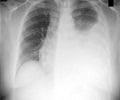
‘In India, mortality (HIV+TB only) was 37 per thousand while incidence (HIV+TB only) was 113 per thousand. Estimated TB incidence in India in 2015 in the age group of 0-14 years for both males and females was 255 per thousand.’
Tweet it Now
It said that in 2015, there were an estimated 10.4 million new (incident) TB cases worldwide, of which 5.9 million (56%) were among men, 3.5 million (34%) among women and 1.0 million (10%) among children while people living with HIV accounted for 1.2 million (11%) of all new TB cases. "Six countries accounted for 60% of the new cases - India, Indonesia, China, Nigeria, Pakistan and South Africa. Global progress depends on major advances in TB prevention and care in these countries," the global health body said in its report.
It said worldwide, the rate of decline in TB incidence remained at only 1.5% from 2014 to 2015 and stressed the need for it to accelerate to a 4 5% annual decline by 2020 to reach the first milestones of the End TB Strategy. In 2015, there were an estimated 480000 new cases of multidrug-resistant TB (MDR-TB) and an additional 100000 people with rifampicin-resistant TB (RR-TB) who were also newly eligible for MDR-TB treatment.
"India, China and the Russian Federation accounted for 45% of the combined total of 580000 cases. There were an estimated 1.4 million TB deaths in 2015, and an additional 0.4 million deaths resulting from TB disease among people living with HIV. Although the number of TB deaths fell by 22% between 2000 and 2015, TB remained one of the top 10 causes of death worldwide in 2015," it said.
WHO said that in 2015, 6.1 million new TB cases were notified to national authorities and reported to WHO while notified TB cases increased from 2013 2015, mostly due to a 34% increase in notifications in India. "However, globally there was a 4. 3 million gap between incident and notified cases, with India, Indonesia and Nigeria accounting for almost half of this gap. The crisis of MDR-TB detection and treatment continues.
Advertisement
This evidence includes household surveys, a state-wide TB prevalence survey, studies of anti-TB drug sales in the private sector, notification data and new analysis of mortality data. "Since India accounts for more than one quarter of the world's TB cases and deaths, these revisions have had a major impact on global estimates. Estimates for India are considered interim, pending a national TB prevalence survey scheduled for 2017/2018," WHO said.
Advertisement
Commenting on the report and the disease in the South East Asian Region which also includes India, WHO Regional Director (SEARO) Poonam Khetrapal Singh said TB remains a serious problem across the region and requires the fullest attention and strongest commitment of governments.
"As outlined in WHO's new global report on TB, a number of countries in the region are among the world's highest TB burden countries, while revised estimates based on increased case-reporting and enhanced surveillance show that the TB caseload is higher than previously projected. TB is the single largest cause of death of any infectious disease in the region, and remains responsible for incalculable suffering, premature mortality, impoverishment and foregone development," she said.
A newer and bolder approach is needed to bend the curve faster and sharper to achieve the global targets. This means intensifying measures to ensure early diagnosis and treatment, such as active case-finding and enhancing access to cutting-edge diagnostic tools.
Source-Medindia














